MSI RTX 2070 Super Gaming X Trio Review
MSI RTX 2070 Super Gaming X Trio Review
A Super-powered Quad HD graphics card with Nvidia ray tracing
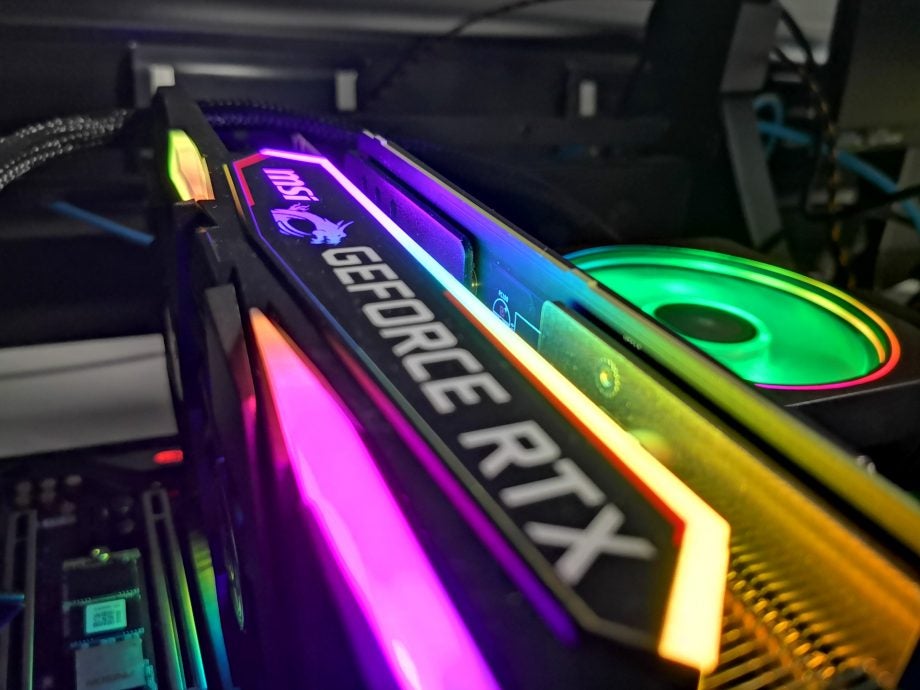
Verdict
A Super-powered Quad HD graphics card which also flaunts Nvidia ray tracing. But if you're after for pound-for-pound value or 4K performance, you're best off looking elsewhere.
Pros
- Excellent Quad HD and Full HD performance w/ modern games
- Flashy design
- Ray tracing support
Cons
- Expensive compared to AMD rivals
- Inconsistent performance
- Too large for mini ATX cases
Key Specifications
- Review Price: £560
- Nvidia Turing architecture
- 2560 CUDA Cores
- 1800MHz boost clock speeds
- VRAM: 8GB GDDR6
- TDP: 215W
What is the MSI RTX 2070 Super Gaming X Trio?
The MSI GeForce RTX 2070 Super Gaming X Trio is a third-party version of Nvidia’s RTX 2070 Super card, a specced-up edition of the standard RTX 2070.
With the older vanilla RTX 2070s being pulled from stores, new Super editions are filling the void it left behind, boasting superior specs – and slightly steeper prices. Nvidia has almost definitely made this move to counter the arrival of AMD’s new RX 5700 and RX 5700 XT graphics cards, providing a blitzing performance and fancy features such as ray tracing, instead of offering bargain-tastic value.
The MSI variant on test here further increases clock speeds, while also optimising overclocking potential with a triple-fan setup to prevent the GPU overheating. But with all of these modifications comes a hefty price, which could well be a deal breaker with its AMD rivals priced so competitively.
Although, don’t forget, the MSI RTX 2070 Super Gaming X Trio is both more expensive and more powerful than the Founders Edition RTX 2070 Super, so don’t take this review as a complete reflection on Nvidia’s own vanilla version.
Related: Best Graphics Card 2019
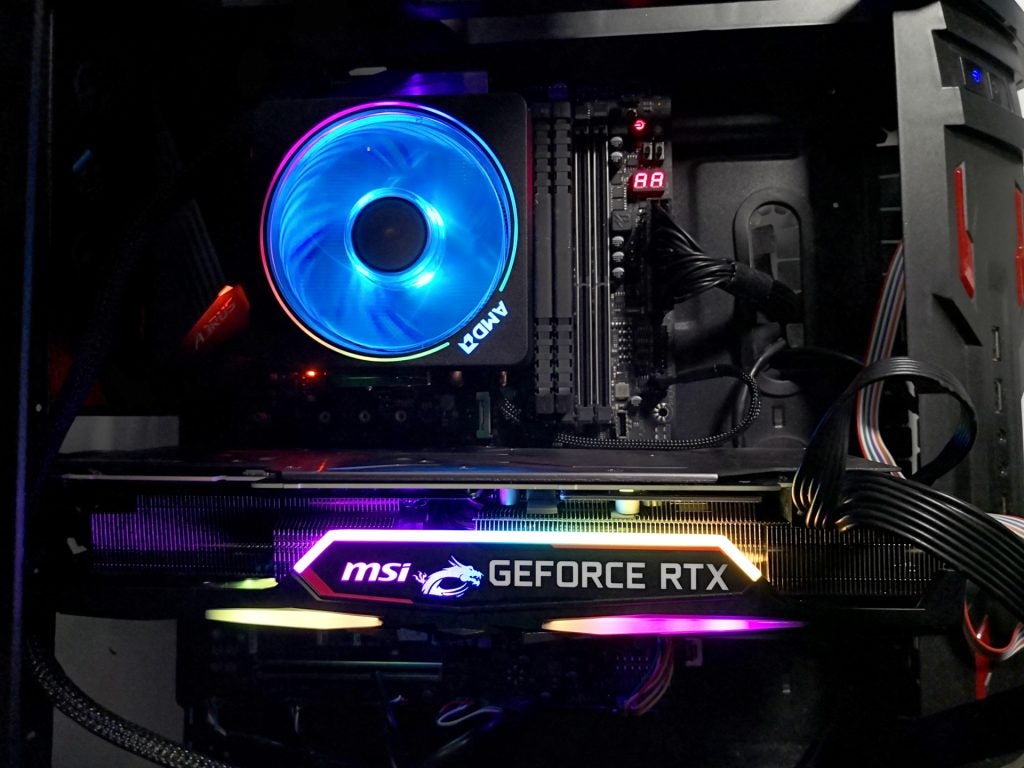
The MSI RTX 2070 Super Gaming X Trio is very heavy on the RGBs, and the fans, and the backplate…
MSI RTX 2070 Super Gaming X Trio – Specs
I’ve already established the MSI RTX 2070 Super Gaming X Trio has seen a specs bump compared to the vanilla RTX 2070 Super, but how major is the difference? Not as significant as you may have expected.
MSI has only improved the boosted clock speed by 30MHz, which isn’t much at all, fallings below the figure posted by AMD’s RX 5700 XT. That said, the performance of a GPU is far more complicated than just clock speeds, so it would be unfair to rely solely on this figure when choosing your card.
| RTX 2070 Super Founders Edition | MSI RTX 2070 Super Gaming X Trio | RTX 2070 Founders Edition | AMD Radeon RX 5700 XT | |
| Architecture | Turing | Turing | Turing | Navi |
| CUDA Cores | 2560 | 2560 | 2304 | NA |
| Boost clock speed (MHz) | 1770 | 1800 | 1710 | 1905 |
| VRAM | 8GB GDDR6 | 8GB GDDR6 | 8GB GDDR6 | 8GB GDDR6 |
| TDP (W) | 215 | 215 | 185 | 225 |
| Price | £475 | £560 | £450 | £380 |
Even the difference between the original RTX 2070 (which Nvidia is no longer selling) and the MSI RTX 2070 Super Gaming X Trio isn’t that substantial when you consider the former costs £110 less. MSI would argue the added cost gets you a better overclocking performance, but I’ll get to that later in this review.
If you’re comparing Nvidia cards to AMD, be aware the former is using Turing architecture which boasts Tensor Cores which accelerates the performance of ray tracing.
Real-time ray tracing is a new revolutionary rendering technique that sees the likes of light effects, shadows and reflections look substantially more impressive and realistic in video games. AMD’s Navi technology sadly has no claim to this technology, but consequently ends up being more affordable than cards with Nvidia’s Turing architecture.
Disappointingly – but not surprisingly – there has been no increase in the 8GB GDDR6 VRAM for any of the RTX 2070 Super GPUs compared to the Founders Edition non-Super RTX 2070 graphics card. Boosting the VRAM could have given the GPUs a significant performance boost, but would likely have seen the price rise dramatically.
Lastly, the TDP (Thermal Design Power) remains the same as Nvidia’s Founders Edition RTX 2070 Super, which only demands slightly more power than the regular RTX 2070. The 215W figure is very impressive, even undercutting AMD RX 5700 XT, but as long as you’ve a powerful enough PSU, the TDP shouldn’t be too much of a concern.
Related: AMD RX 5700 XT review
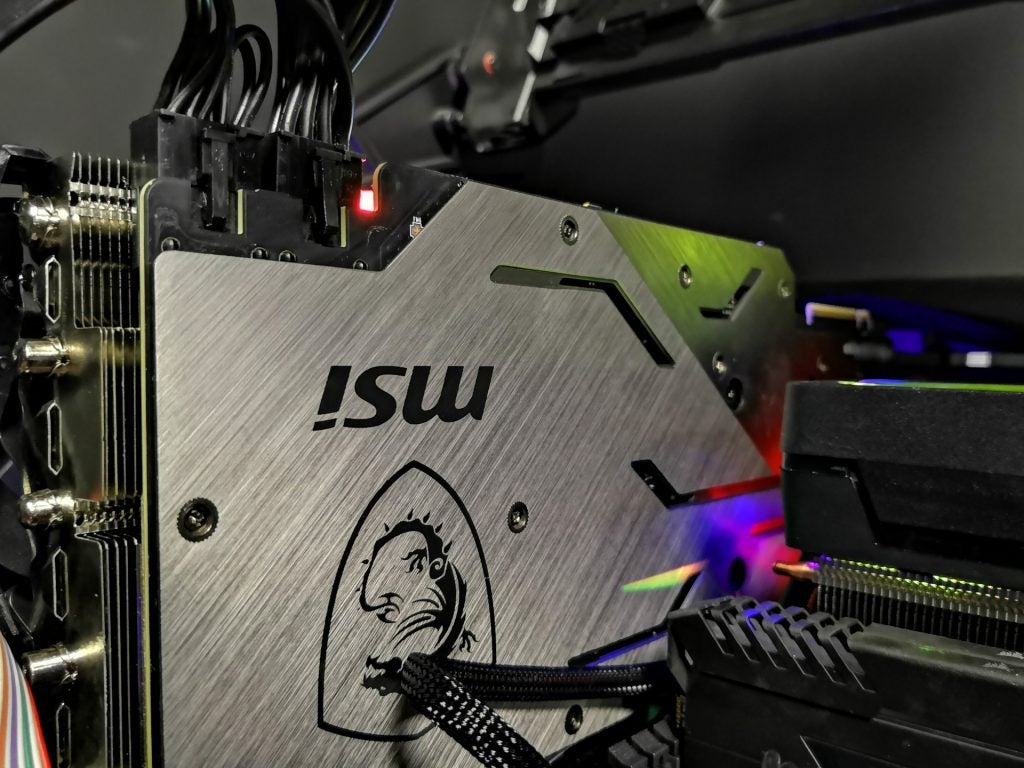
Heavy metal: The MSI 2070 Super is a big beast – it occupies a 2.75 slot and measures 140 x 56.5 x 328 mm
MSI RTX 2070 Super Gaming X Trio – Design
The MSI RTX 2070 Super Gaming X Trio is one of the biggest graphics cards I’ve seen – it’s even longer than the width of our ATX motherboard. At 328mm long and 56.5mm thick, it’s best advised you don’t try and fit this graphics card inside a mini ATX case.
The graphics card’s extravagant size is due to the presence of three TORX Fans, which help to keep temperatures cool regardless what GPU-intensive games you’re running. The MSI dragon logos on the centre of the fans help provide some snazzy personality flair, which is arguably absent from the Nvidia Founders Edition cards.
There are also RGB light strips running along the edges of the card, which you can customise via the MSI Mystic Light utility for various colours and effects, and even sync up with other components for a dazzling rainbow harmony. This could be a little overbearing for some gamers, but I personally like to see my rigs glow with a wide spectrum of colours.
On the rear you’ll find three output ports for DisplayPort and a single connection for HDMI 2.0. Sadly there’s no port for USB-C, which is a slight disappointment considering more and more virtual reality headsets are opting for the streamlined connection. In more positive news, the MSI RTX 2070 Super Gaming X Trio is SLI-Ready, so if you’re really keen on hooking up multiple GPUs (although we don’t recommend it, unless you really know what you’re doing) then you have the option here.
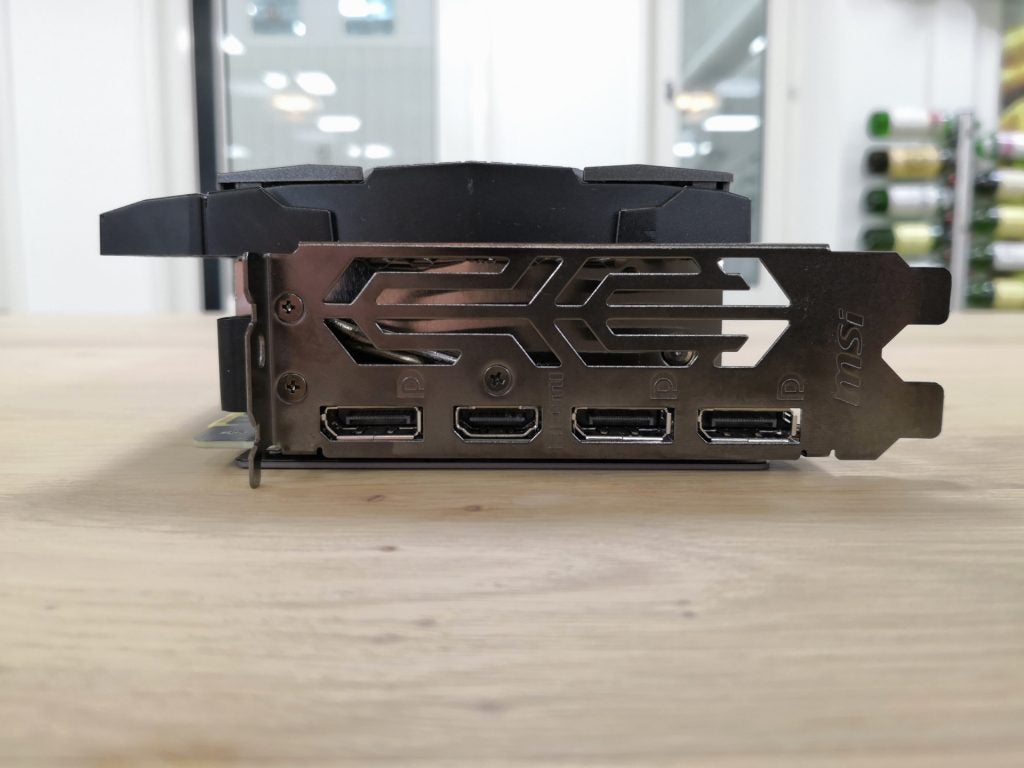
L-R: DisplayPort, HDMI 2.0, and two more DisplayPorts.
Related: AMD RX 5700 review
MSI RTX 2070 Super Gaming X Trio – Ray tracing and DLSS
The biggest difference between a Nvidia Turing and an AMD Navi graphics card, other than price, is ray tracing. Real-time ray tracing is a new rendering technology which makes in-game light behave and look more realistically. This results in more authentic lighting effects, shadows and reflection, which can dramatically improve the visuals.
However, real-time ray tracing technology is very much in its infancy, even almost a year after the first 20 Series cards featuring it were announced. Firstly, only a few big games support it right now, with Metro Exodus, Battlefield 5 and Shadow of the Tomb Raider being the only big name titles at the time of writing.
On left: DXR turned off. On right: DXR turned on (Game: Battlefield 5)
More ray tracing supported games have been confirmed for the future, including Control, Watch Dogs Legion and Cyberpunk 2077 – and many more expected to follow when the PS5 and Xbox 2 launch – but that’s still a long wait to see a return on your investment.
The second issue is that activating ray tracing can see the frame rate take a tumble, since the technology is such a drain on the GPU. When turning DXR (DirectX Raytracing) on in Battlefield 5 with the MSI RTX 2070 Super Gaming X Trio in the rig, the frame rate dropped from 100fps to 70fps which is a whopping 30fps decline.
Fortunately, another Nvidia feature called DLSS (Deep Learning Super Sampling) has been introduced to rectify this performance drop. This feature uses artificial intelligence to alleviate some of the GPU workload, consequentially giving the frame rate a lovely boost.
| DXR off | DXR on, DLSS on | DXR on, DLSS off | |
| Battlefield 5 FPS | 100 | 80 | 70 |
As our table shows, DLSS boosted the frame rate in Battlefield 5 (in Quad HD, with DXR activated) by 10fps. That’s not quite enough to recover the whole 30fps loss, but it’s still a welcome bump.
Another issue with DLSS in its current state is that it negatively impacts the visual quality. The picture isn’t quite as sharp with DLSS activated, with textures becoming less detailed.
On left: DLSS turned off. On right: DLSS turned on (Game: Battlefield 5)
Nvidia seems to be in the process of ironing out these flaws, most recently introducing a DLSS slider in Monster Hunter World which lets gamers balance out the visual quality and frame boost themselves. But, with ray tracing and DLSS both still facing teething troubles, you’re going to have to wait a number of months until you reap all the benefits. It’s something of a known unknown, and therefore still represents a degree of risk.
Related: What is ray tracing?
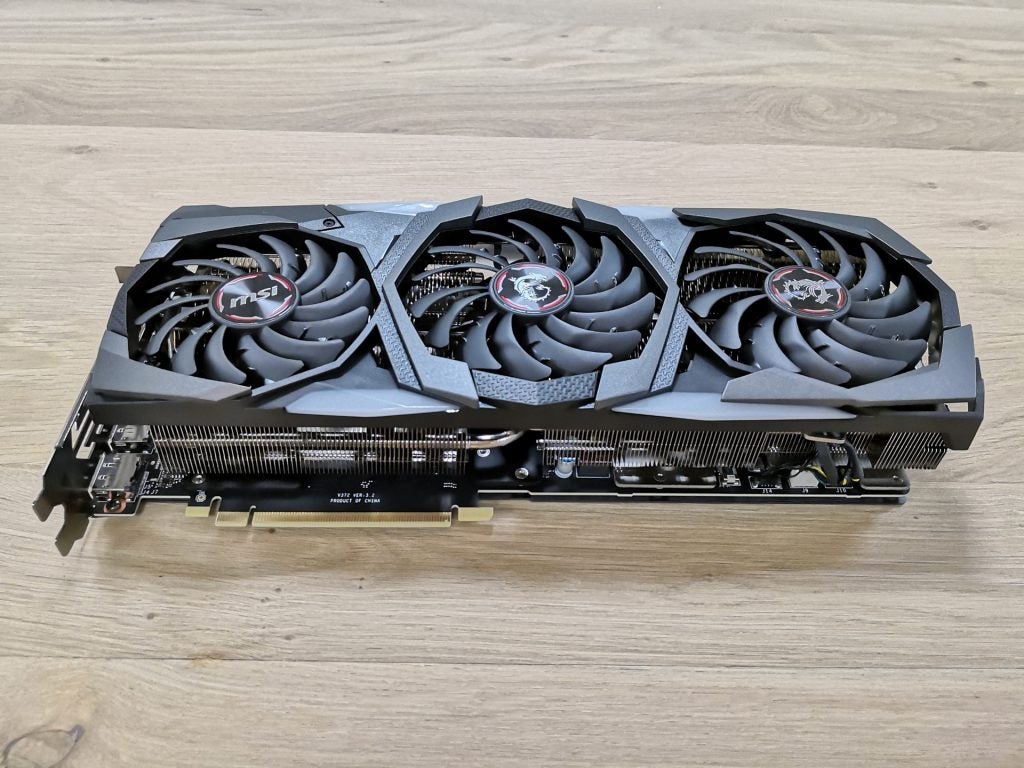
The trademark MSI dragon design extends to the fans as well as the backplate
MSI RTX 2070 Super Gaming X Trio – Performance
The MSI RTX 2070 Super Gaming X Trio is a high-performing mid-range graphics card. This puts it in a rather awkward position, being one of the most expensive GPUs for Quad HD gaming, yet is still not powerful enough to comfortably run games in 4K.
Disappointingly for the MSI RTX 2070 Super Gaming X Trio though, its performance was hit and miss. With the likes of The Division 2, I saw a decent frame rate improvement over the regular RTX 2070, but with other titles such as Shadow of the Tomb Raider and Dirt Rally, there seemed to be no frame rate boost at all.
This inconsistency is alarming, although this could be down to software issues which could be patched eventually. Then again, the difference in specs for these cards is so minor it’s not a massive surprise that there’s little separating the performance of the cards on test.
Judging from my benchmark results, AMD’s 5700 XT GPU seems to be the closest rival to MSI’s RTX 2070 Super, despite costing £95 less. Of course, the latter also features ray tracing, which may well be worth the extra cash for some. I used the following four graphics cards for the benchmark tests:
- MSI RTX 2070 Super Gaming X Trio
- Asus ROG Strix RTX 2070 O8G Gaming
- Asus Dual RTX 2060 Super O8G-EVO
- AMD Radeon RX 5700 XT
Testing methodology
I used the same computer rig to test every graphics card in order to ensure a fair test. The CPU, SSD, RAM, motherboard and PSU were all kept consistent throughout the testing process. Have a look at the exact components we used below:
Motherboard: X570 Aorus Master Gaming
Processor: AMD Ryzen 9 3900X
RAM: Corsair Vengeance 2666MHz, 16GB DDR4
PSU: Corsair CX750M
OS: Windows 10
I also carefully considered which games I’d use for the testing process. Shadow of the Tomb Raider was chosen as our Nvidia-optimised GPU, while The Division 2 was picked for AMD. Both of these titles are two of the most GPU-demanding games currently available, which makes them ideal for pushing GPUs as far as they can go. Dirt Rally was also selected as an indicator of how well the GPU can perform with games released a number of years ago.
For each benchmark test, I picked the highest graphics preset (highest, ultra etc) while making sure to disable the likes of Vsync, which could allow the refresh rate of the monitor to influence the performance. See below for the results:
Shadow of the Tomb Raider
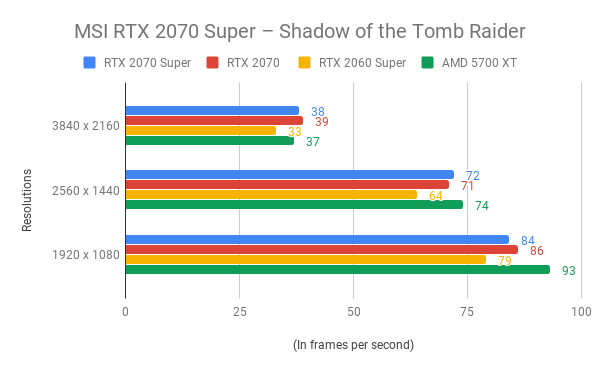
The Shadow of the Tomb Raider frame rate results posted by the MSI RTX 2070 Super Gaming X Trio came as a big shock, and fell well short of my expectations. It saw almost identical results to the Asus ROG Strix RTX 2070 O8G Gaming (which isn’t so outlandish because the latter has slightly superior boost clock speed) and was also bested by AMD’s RX 5700 XT. These results were disappointing given the card’s steep price.
That said, if you ignore the competition, MSI’s RTX 2070 Super still posted excellent results for Quad HD and Full HD gaming at 72fps and 84fps, respectively. This is above the recommended optimum 60fps performance, so Shadow of the Tomb Raider should run very smoothly.
The 4K result wasn’t too shabby either at 38fps. This frame rate is certainly high enough to be playable, but you’d want something closer to 60fps for an ideal performance.
The Division 2
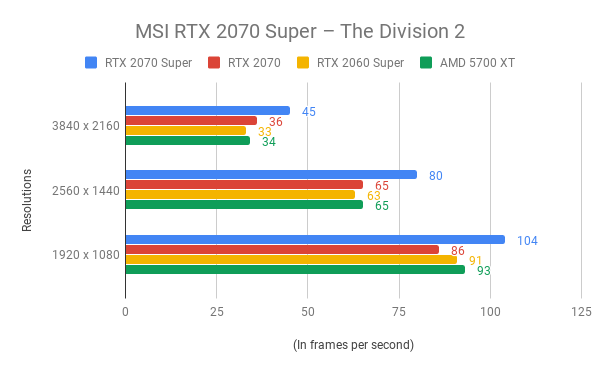
Ubisoft’s The Division 2 is a far better showcase for what the MSI RTX 2070 Super Gaming X Trio is capable – with a Quad HD performance of 80fps on average, it bested both the RTX 2070 and AMD’s RX 5700 XT by a stonking 15fps.
The MSI RTX 2070 performance for Full HD was also very impressive at 104fps. Again, this reflected its superior GPU muscle over the other cards on test, offering a stellar performance well beyond the optimum 60fps.
The 4K result looked decent too, with a 45fps average. The level of performance is admittedly on the low-end, but it’s still just about high enough to be playable – you just have to decide between visual fidelity and smooth performance, depending on which is more important to you.
I’m unsure why the MSI RTX 2070 Super performance was so high with The Division 2 and yet was underwhelming with Shadow of the Tomb Raider, but it’s likely to be a driver issue. Still, it’s concerning how inconsistent this graphics card seems to be with each game.
Dirt Rally
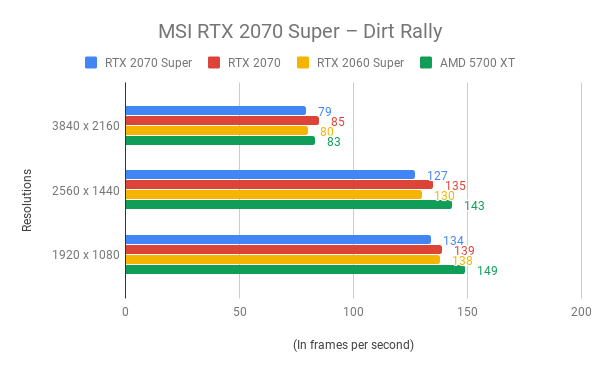
If you were hoping the underwhelming Shadow of the Tomb Raider results were just an anomaly, the Dirt Rally benchmark results unfortunately proved otherwise. The MSI RTX 2070 Super Gaming X Trio came bottom of the pack for everyone one of the benchmark tests in our four-way face off, despite being the most expensive card.
These low results will likely be due to one of two reasons: the MSI RTX 2070 Super is in need of a new driver to unlock its performance potential, or, the graphics card is simply not very well optimised for older games. It’s hard to say which is true at the time of writing.
But while the likes of AMD’s RX 5700 XT look to have the MSI RTX 2070 Super well beat for Dirt Rally, the latter still saw exceptionally good results. Whether you’re playing the racer in Full HD, Quad HD or 4K, you’re going to see an incredibly good performance with everyone one of the figures leaving the golden standard 60fps in the dust.
3DMark Fire Strike Ultra
The 3DMark Fire Strike Ultra benchmark software is useful for testing the raw performance of a graphics card, giving a good estimate of the average GPU performance. This of course, won’t provide an indication of in-game performance, but it’s still a good basis for comparing cards.
Interestingly, its benchmark score of 6133 is the best of the four cards on test. Judging from specs and price, this is the result you’d expect, but in-game benchmark results don’t really align with this figure, supporting the suggestion software could be negatively impacting frame rates for select games. That said, the 3DMark Fire Strike Ultra result also shows the AMD 5700 XT isn’t far behind the MSI RTX 2070 Super in terms of performance despite the gulf in price difference.
The Fire Strike Ultra benchmark also showed the MSI RTX 2070 Super to be a power leech, with a peak power consumption of 366 watts. This was a higher figure than all three of the other graphics cards on test, but not to such an extent that you’ll need to be worrying about your PSU.
The triple-fan design of the MSI RTX 2070 Super also ensures a respectable temperature of 65°C when running the 3DMark Fire Strike Ultra benchmark. That is 15°C less than the AMD 5700 XT, which sees temperatures rising worryingly high.
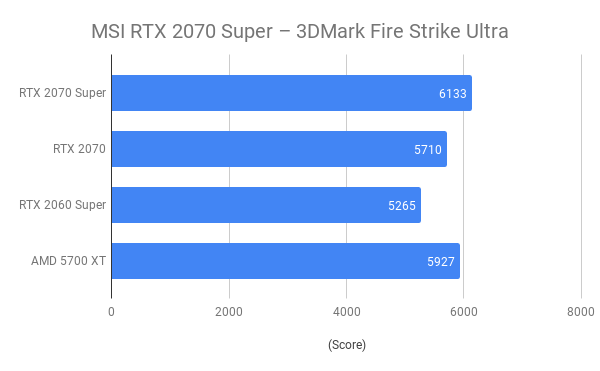
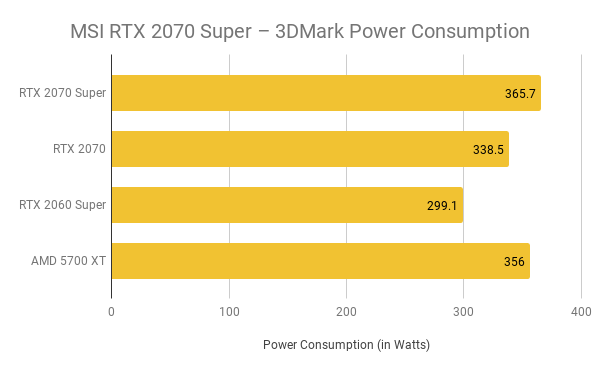
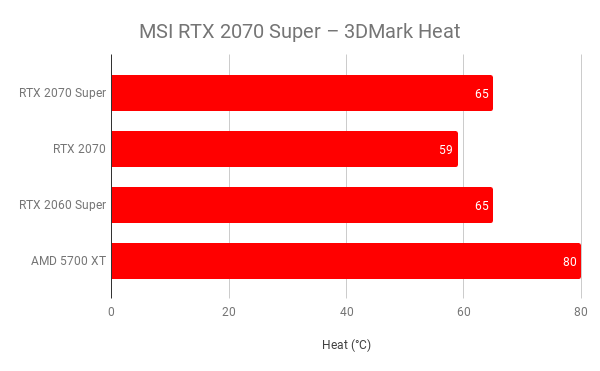
MSI RTX 2070 Super Gaming X Trio – Overclocking
You’d think the MSI RTX 2070 Super Gaming X Trio would excel at overclocking, what with its three fans and boosted specs. But, while it was capable of a 140MHz overclock, I couldn’t push it any further without the Unigine Heaven software turning into a stuttering mess, which was disappointing.
This overclock only resulted in a 7.7fps performance boost in Unigine Heaven, which is decent, but arguably not substantial enough to justify the card’s steep price when compared to the AMD RX 5700 XT.
More seasoned overclockers who have more time to push the graphics card to its limit may see a greater performance boost, but with the performance becoming so unstable following a 150MHz overclock, I doubt they’ll be able to see a huge return of frame rates.
That said, the temperature never exceeded 68°C, which is far below the point when the heat comes concerning. This shows its not the thermal performance that’s the bottleneck here, but more the limitations of the hardware.
Related: RTX 2060 Super Review
Should I buy the MSI RTX 2070 Super Gaming X Trio?
There’s a reason Nvidia discontinued the standard RTX 2070, with the upper mid-range graphics card arguably suffering middle sibling syndrome – it didn’t offer fantastic Quad HD value and was too under-powered to compete on the 4K front. Sadly, speccing up the RTX 2070 for the Super edition hasn’t fixed this issue.
The extra flashy design details MSI brings to the RTX 2070 at least gives the graphics card extra flair. The MSI dragon logos and RGB lights make this one of the flashiest cards I’ve seen yet, while the third fan is ideal for keeping things cool during an overclock. But these extra features also drive up the price, which is detrimental when AMD’s significantly cheaper RX 5700 XT isn’t too far behind in terms of performance.
That’s not to say the MSI RTX 2070 Super Gaming X Trio doesn’t have any appeal. If you’re using a Quad HD monitor and want the highest possible frame rates for under £600, then this a worthwhile option – just be aware you can get better value with rival cards.
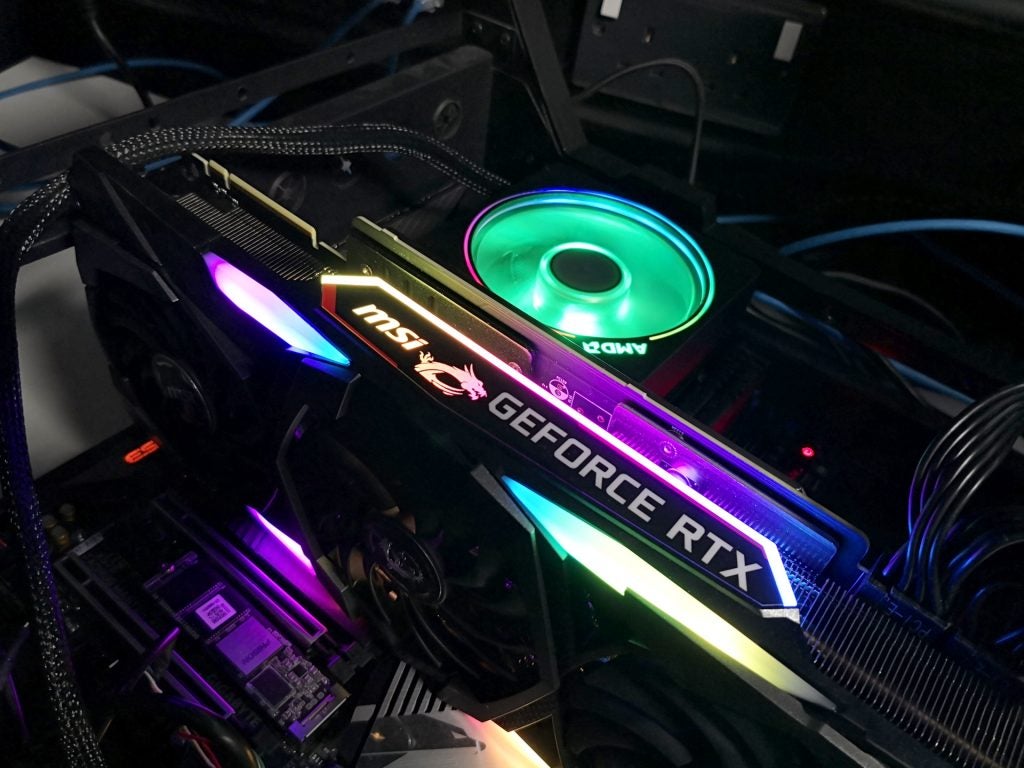
MSI’s RTX 2070 Super offers great Quad HD gaming performance, but, if that’s all you’re after…
Verdict
The MSI RTX 2070 Super Gaming X Trio appeals to a very niche audience – those who want the best possible Quad HD and ray tracing graphics card available for under £600, but aren’t prepared to make the jump to 4K.
If that suits you to the ground, and you’re happy to pay the premium for MSI’s flashy RGB lights and design, then this graphics card will serve you well. But if you’d rather save your cash and get the best value GPU card on offer, then AMD’s alternatives are a far better bet.


